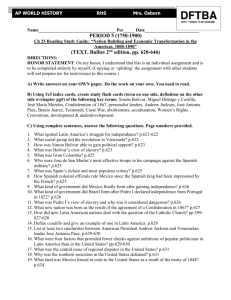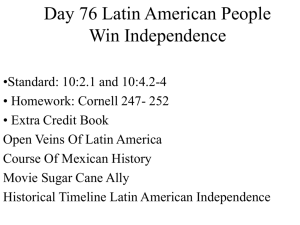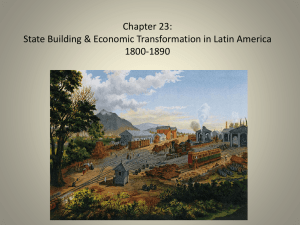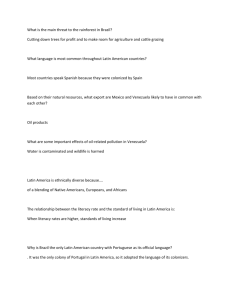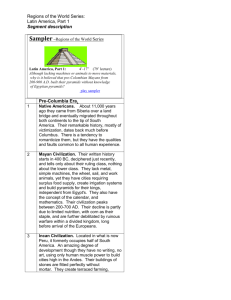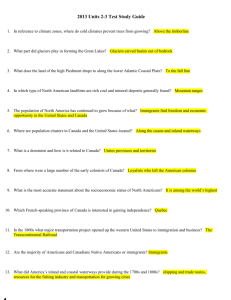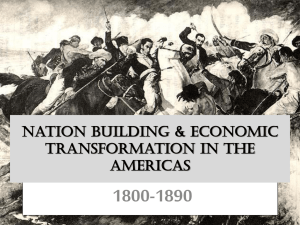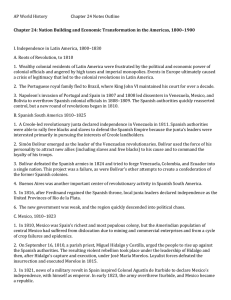AP World History: Nation Building in the Americas, 1800-1890
advertisement
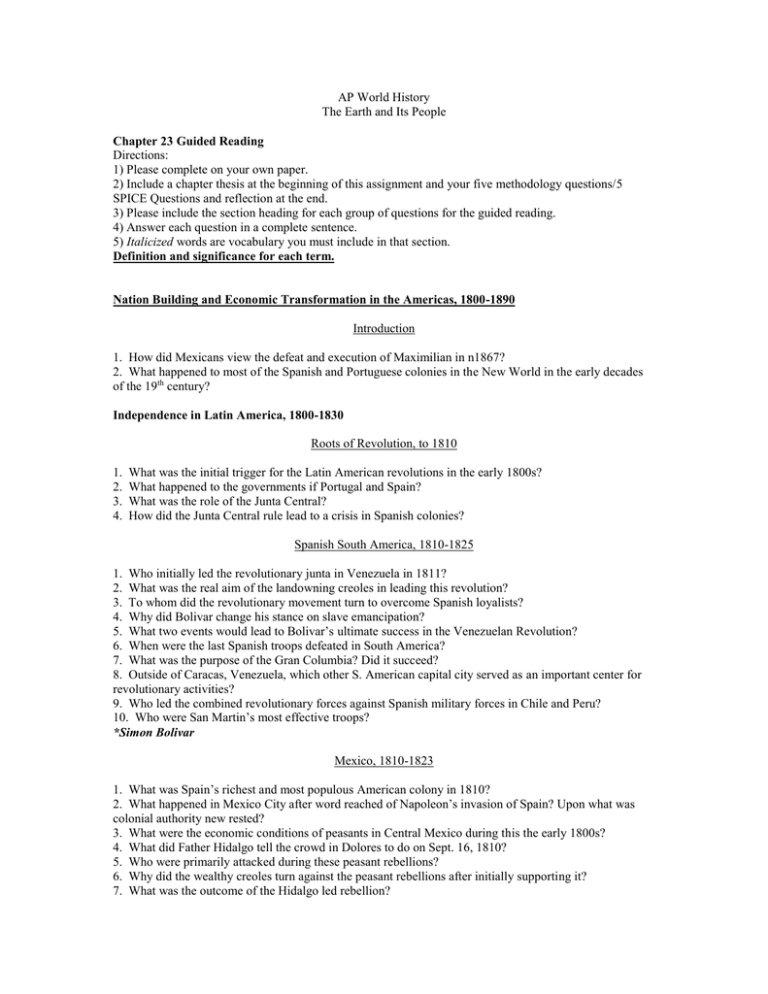
AP World History The Earth and Its People Chapter 23 Guided Reading Directions: 1) Please complete on your own paper. 2) Include a chapter thesis at the beginning of this assignment and your five methodology questions/5 SPICE Questions and reflection at the end. 3) Please include the section heading for each group of questions for the guided reading. 4) Answer each question in a complete sentence. 5) Italicized words are vocabulary you must include in that section. Definition and significance for each term. Nation Building and Economic Transformation in the Americas, 1800-1890 Introduction 1. How did Mexicans view the defeat and execution of Maximilian in n1867? 2. What happened to most of the Spanish and Portuguese colonies in the New World in the early decades of the 19th century? Independence in Latin America, 1800-1830 Roots of Revolution, to 1810 1. 2. 3. 4. What was the initial trigger for the Latin American revolutions in the early 1800s? What happened to the governments if Portugal and Spain? What was the role of the Junta Central? How did the Junta Central rule lead to a crisis in Spanish colonies? Spanish South America, 1810-1825 1. Who initially led the revolutionary junta in Venezuela in 1811? 2. What was the real aim of the landowning creoles in leading this revolution? 3. To whom did the revolutionary movement turn to overcome Spanish loyalists? 4. Why did Bolivar change his stance on slave emancipation? 5. What two events would lead to Bolivar’s ultimate success in the Venezuelan Revolution? 6. When were the last Spanish troops defeated in South America? 7. What was the purpose of the Gran Columbia? Did it succeed? 8. Outside of Caracas, Venezuela, which other S. American capital city served as an important center for revolutionary activities? 9. Who led the combined revolutionary forces against Spanish military forces in Chile and Peru? 10. Who were San Martin’s most effective troops? *Simon Bolivar Mexico, 1810-1823 1. What was Spain’s richest and most populous American colony in 1810? 2. What happened in Mexico City after word reached of Napoleon’s invasion of Spain? Upon what was colonial authority new rested? 3. What were the economic conditions of peasants in Central Mexico during this the early 1800s? 4. What did Father Hidalgo tell the crowd in Dolores to do on Sept. 16, 1810? 5. Who were primarily attacked during these peasant rebellions? 6. Why did the wealthy creoles turn against the peasant rebellions after initially supporting it? 7. What was the outcome of the Hidalgo led rebellion? 8. Who was Jose Maria Morelos and what happened to the rebellion under him? 9. What European event happened in 1820 that sparked Mexican independence by 1821? *Miguel Hidalgo y Costilla, Jose Maria Morelos Brazil. To 1831 1. 2. 3. 4. 5. 6. Why was King John VI of Portugal forced to leave Brazil in 1821? Who was left behind to rule Brazil in his absence? How did Pedro’s government differ from those who had recently gained independence? How did Pedro I make powerful enemies in Brazil? What phrase did Pedro I use to describe the institution of slavery? Who gained the Brazilian throne after Pedro I was forced to abdicate in 1831? The Problem of Order, 1825-1890 1. What political idea found broad support across the hemisphere after these independence movements of the early 1800s? 2. Which two countries still maintained monarchies? Constitutional Experiments 1. Why did Latin American governments espouse constitutionalism? 2. Why did so many Latin American constitutions fail? 3. Why did the United States Constitution in 1781 have advantages over similar attempts in Latin America? 4. How were Latin American constitutions similar to the United Constitution when it came to voting rights? 5. What exposed the weaknesses of localized rule in British Canadian provinces in the 1800s? 6. How did the Confederation of 1867 help resolve these local difficulties? 7. Why did the people of Latin America struggle more with constitutional issues than did the people of North America? 8. How did the role of the Catholic Church fit in during the constitutional process? 9. Why was it possible for many Latin American militaries to successfully resist civilian control in government? *Confederation of 1867, Personalist Leaders 1. What did ‘personalist leaders’ rely on as their foundation for personal political power? 2. Who served as the model for these personalist leaders? 3. What is a caudillo? 4. How were attempts in the U.S. and Latin America different when it comes to leaders challenge of constitutional limits on their authority? 5. Despite their role in the independence movements, which class of people were generally left out when it came to full political participation? 6. What did Simon Bolivar attempt to establish in Latin Americ? 7. Why did many local independence leaders challenge Bolivar’s authority? 8. How did Jose Antonio Paez win over the support of the masses? 9. What was truly unique about Andrew Jackson and his climb to the White House? 10. How were Jackson and Paez similar? 11. How did Jackson view his presidential victories in 18128 and 1832? 12. Which two seemingly different policies did both Jackson and Paez ‘blend’ together in order to dominate national politics? 13. What caused Latin American personalist leaders (caudillos) to have fewer restraints on their power than their N. American counterparts? * Personailst Leaders, Andrew Jackson, Jose Antonio, Perez The Threat of Regionalism 1. How did new nationalist governments compare to the pre-Independence governments that they replaced? 2. What happened to all post-Independence efforts to forge large multi-state federations? 3. Which two post-Independence forces competed for political control of Argentina before the rise of military dictator Juan Manuel de Rosas? 4. What was a primary reason for the creation of the U.S. Senate? 5. What was the significance of the formula for representation in the U.S. House of Representatives? 6. What was the key issue that divided the U.S. into two separate and competitive societies? 7. Explain why new territorial acquisitions by the U.S. (like Louisiana) proved to be a mixed blessing to the defenders of slavery. 8. Why did the southern states chose secession due to Lincoln’s 1860 election? 9. What was the end result of the Union victory in the Civil War? 10. What reason does the text give for the failure of the Confederacy to secede from the Federal Union? Foreign Interventions and Regional Wars 1. Which four countries had successfully waged wars against their neighbors and established themselves as regional powers? 2. How were the War of 1812 and the Spanish-American War of 1898-1899 different? 3. The wars between which two political parties in Mexico weakened them enough to give France a chance to invade in 1862? 4. Which Mexican president was force to flee Mexico City as a result of the conservative-French alliance? 5. Who became the new ‘emperor’ of Mexico in 1862? What was eventual fate in 1867? 6. Why were U.S. citizens settling in the Texas region during the 1820s? 7. How did the issue of slavery affect Mexico-Texas relations? 8. What was the result of Mexico’s loss to Texan rebels in 1836-37 and subsequent losses to the United States in 1847? 9. What was the end result of regional wars between Chile versus Peru-Bolivia and Argentina and Brazil versus Uruguay and Paraguay? *Benito Juarez Native Peoples and the Nation-State 1. How did the colonial powers’ role between their colonies and the Amerindian natives change following independence? 2. After initial victories, Amerindians military resistance was finally overcome by which decade? 3. To whom did Native American leaders turn to in order to prevent to vast overrunning of their lands by American settlers in the early 1800s? 4. Which Shawnee leaders formed a larger alliance between southern and western Native Americans after 1800? 5. What happened to this alliance in 1811 and their most famous leader in 1812? 6. What was called for in the Indian Removal Act of 1830? 7. What happened during this ‘Trail of Tears?’ 8. Why were Great Plains Indians able to offer formidable resistance to white expansion across the West? 9. How were Great Plains Indian women affected by the rise of firearms? 10. Despite their resistance, most Native Americans were relegated to these by the late 1880s? 11. What terms does the text use to describe the three phases of Native American interaction with European settlers? 12. What advantage did Amerindians in Argentina have in checking settler’s southern expansion? 13. How were military campaigns against Native Americans in the U.S., Chile, and Argentina justified? 14. What was the reason for the Caste War in 1847 and why did the Mayan chose that time to rebel? * Tecumseh, Caste War The Challenge of Economic and Social Change 1. What did most Western Hemisphere economies become increasingly dependent on during the 19 th century? 2. How did increased participation in international markets affect the region’s economies? The Abolition of Slavery 1. Were independence movements generally pro-slavery or anti-slavery? 2. Define abolitionists. 3. Why was slavery hard to abolish in the United States, Brazil, and Cuba? 4. What reason did abolitionists often use to encourage slavery’s end? 5. What was the role of women in abolition? 6. Which U.S. political party force a confrontation between slave and free states? 7. When was Russian serfdom abolished? 8. Was abolished slavery in the U.S. in 1865? 9. How did the Paraguayan War of 1865-70 help end slavery in Brazil by 1888? 10. Why was there little enthusiasm about independence from European imperial governments by Caribbean settlers? 11. How did slaves rebellions and resistance help end slavery in French Caribbean colonies? 12. What did the British do after the profitability of their plantations declined in the early 1800s? 13. Where did slavery last the longest in which Caribbean Islands? 14. Who used their nay to enforce abolition treaties? *Abolitionists Immigration 1. What was the relationship between the number of European immigrants and African slaves entering the Western Hemisphere between 1500 and 1760? 2. What was the effect of increased immigration after the end of slavery? 3. Where did the majority of immigrants to the western hemisphere come from during the 19 th century? 4. During what decade did the greatest number of immigrants come to America? 5. After 1870, most immigrants came from these regions of Europe? 6. Nativist political movements often labeled immigrants as ‘desirable’ and ‘undesirable.’ Who was more likely an ‘undesirable’ – an Asian or European? 7. How did the U.S. and Canada attempt to make Asian immigration more difficult in the 1880s? 8. Why were many immigrants looked down on? 9. What did schools in the Americas attempt to create as a reaction to immigration? American Cultures 1. How did the creation of ethnically based mutual aid societies worsen the fears of native-born Americans? 2. Define acculturation. 3. What European immigrant political beliefs influenced the labor movements of Mexico, Argentina, and the United States? *acculturation Women’s Rights and the Struggle for Social Justice 1. 2. 3. 4. 5. What was the reason for the forming of the Women’s Rights Convention? When and where was the women’s rights convention held and what was its issued statement? Where did women generally provide leadership before being granted full enfranchisement? What occupation did women dominate by the end of the 19 th century? How did working-class women transform gender relations? 6. Which region was more likely to insist on formal racial segregation, the American South or Latin American nations? *Women’s Rights Convention Development and Underdevelopment 1. What 3 things stimulated economic expansion between 1800 and 1900? 2. Which was the only Western Hemisphere nation to industrialize during the 19 th century? 3. Who were the only 3 nations in the West to achieve similar income levels as Western Europe by 1900? 4. The demand for which precious metals and materials led to a mining boom in the western U.S., Mexico, and Chile? 5. Who owned most new mining companies in these countries? 6. How were these mines different from colonial era mines? 7. Which new technologies accelerated economic integration of the hemisphere’s governments? 8. Which new technologies helped make Argentinean beef more profitable? 9. What are two characteristics of a ‘developed’ nation? 10. What characterizes an ‘underdeveloped’ nation? 11. Which was the only Latin American country to imitate U.S. and Canadian 19 th century prosperity? 12. What cyclical swings positively effected U.S. and Canadian economic prosperity after their independence? 13. How was the time of Latin America’s independence movement different? *development, underdevelopment Altered Environments 1. How did sugar plantations affect Cuba’s natural environment? 2. When given the choice between economic growth and environmental protection, what did all nations choose?
